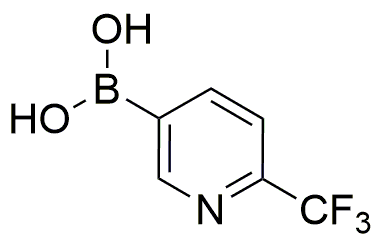2-(Trifluoromethyl)pyridine-5-boronic acid is widely utilized in research focused on:
- Pharmaceutical Development: This compound serves as a key intermediate in the synthesis of various pharmaceuticals, particularly in creating compounds that target specific biological pathways, enhancing drug efficacy.
- Organic Synthesis: It is employed in cross-coupling reactions, such as Suzuki reactions, to form carbon-carbon bonds, which are essential in building complex organic molecules.
- Agricultural Chemistry: This chemical is used in the development of agrochemicals, including herbicides and pesticides, providing effective solutions for crop protection and yield enhancement.
- Material Science: It plays a role in the formulation of advanced materials, including polymers and coatings, due to its unique electronic properties, which can improve material performance.
- Analytical Chemistry: The compound is utilized in various analytical techniques for detecting and quantifying other substances, making it valuable in quality control and environmental monitoring.
General Information
Properties
Safety and Regulations
Applications
2-(Trifluoromethyl)pyridine-5-boronic acid is widely utilized in research focused on:
- Pharmaceutical Development: This compound serves as a key intermediate in the synthesis of various pharmaceuticals, particularly in creating compounds that target specific biological pathways, enhancing drug efficacy.
- Organic Synthesis: It is employed in cross-coupling reactions, such as Suzuki reactions, to form carbon-carbon bonds, which are essential in building complex organic molecules.
- Agricultural Chemistry: This chemical is used in the development of agrochemicals, including herbicides and pesticides, providing effective solutions for crop protection and yield enhancement.
- Material Science: It plays a role in the formulation of advanced materials, including polymers and coatings, due to its unique electronic properties, which can improve material performance.
- Analytical Chemistry: The compound is utilized in various analytical techniques for detecting and quantifying other substances, making it valuable in quality control and environmental monitoring.
Documents
Safety Data Sheets (SDS)
The SDS provides comprehensive safety information on handling, storage, and disposal of the product.
Product Specification (PS)
The PS provides a comprehensive breakdown of the product’s properties, including chemical composition, physical state, purity, and storage requirements. It also details acceptable quality ranges and the product's intended applications.
Certificates of Analysis (COA)
Search for Certificates of Analysis (COA) by entering the products Lot Number. Lot and Batch Numbers can be found on a product’s label following the words ‘Lot’ or ‘Batch’.
Numéro de catalogue
Numéro de lot/série
Certificates Of Origin (COO)
This COO confirms the country where the product was manufactured, and also details the materials and components used in it and whether it is derived from natural, synthetic, or other specific sources. This certificate may be required for customs, trade, and regulatory compliance.
Numéro de catalogue
Numéro de lot/série
Safety Data Sheets (SDS)
The SDS provides comprehensive safety information on handling, storage, and disposal of the product.
DownloadProduct Specification (PS)
The PS provides a comprehensive breakdown of the product’s properties, including chemical composition, physical state, purity, and storage requirements. It also details acceptable quality ranges and the product's intended applications.
DownloadCertificates of Analysis (COA)
Search for Certificates of Analysis (COA) by entering the products Lot Number. Lot and Batch Numbers can be found on a product’s label following the words ‘Lot’ or ‘Batch’.
Numéro de catalogue
Numéro de lot/série
Certificates Of Origin (COO)
This COO confirms the country where the product was manufactured, and also details the materials and components used in it and whether it is derived from natural, synthetic, or other specific sources. This certificate may be required for customs, trade, and regulatory compliance.


